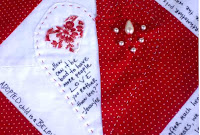
This is a copy of my add from "Artisan World" Catalogue II. This is the second Catalogue put out by Artisanimpact.etsy.com; two very talented artisans, Oded and Ilan and their assistant, Ev - of whom I have written about often throughout my blog. About 80,000 catalogues are distributed throughout the world to different artists, jewelers, etc. - I wish them and all those whose ad's are represented in this beautiful Catalogue.
ps - Besides doing the Introduction & Bio once again, I was asked to write a 2-page article on the different types of art today; many of which correlate back almost 2,000 years.
Art: In an Artisan World
“Art is something that makes us more thoughtful and inspired.” When people use the term “Art”, what generally comes to mind is “visual art”; basically anything that stimulates the human senses, as well as the human mind. It is a way of communicating inner thoughts, emotions, and feelings through the many forms of the artistic world. Aristotle’s philosophy of art is classically defined as “that which when seen, pleases. Pleasure is the final cause of beauty and thus is not a means to another end, but an end in itself.”
Artisan World’s second catalogue’s goal is to bring to the consumer a “visual art” based on a particular artist’s ideas, experiences, emotions, expressions, and beliefs. These creations show beautiful, thought-provoking works in which the artist presents his own skills and techniques. The “visual expression” of their talents and ideas are then channeled into a creative piece which reaches out to the emotions of its admirer. As you view this Catalogue, remember that this is only a catalyst through which the imagination of each artist is brought forth, and a chance to experience the many varied forms of “artisans” today.
Art can be defined in many ways. “Fine art”, refers to those paintings whose sole purpose is to exist; while “decorative art”, is that which brings to life art in a practical form to ordinary objects of everyday life. Decorative art uses specific mediums in the creation of jewelry, textiles, woodworking, sculpting, and other creative works of art. Within this realm of what we call “decorative art” is another form called “encaustic art”, which dates back over 2000 years to Greek and Roman times.
Looking at a painting, think of how the artist uses the blending of colors or his brush. Different strokes of the brush, define different emotions that the particular artist may be feeling at that time. An artist using dark bold colors may reflect inner turmoil or a more forceful personality; an artist using delicate colors and stokes is emoting an inner sense of calm and beauty. All defined as “fine art”. “Craftsmanship” is an art which involves working with specific metals, such as gold, silver or copper to create pieces of jewelry or sculptures; a reflection of the person working to make a particular artistic form. “Encaustic art” dates back to ancient times when hot liquid colors were applied to walls by means of heated irons. Today, encaustic painting is produced through a process in which the colored wax is permanently ‘burned’ into an absorbent backing such as plaster, canvas or some woods while using special irons, or scribing tools. Many of the artists then design their work into an ACEO (Art Card Edition & Original).
A new subject gaining popularity among some artisans is referred to as “Eco-art”, which is defined by the ecological impact of the environment, in relation to the artist. The eco-artist will convey a particular artwork based on the defilement of the earth’s own environment. As one artist put it, “one person can make a difference; and character and environment are everything.” They find encouragement in creating new life for would-be discards. Another word describing this type of artwork would be “recycling.” “Graffiti Art” is another modern art form which can again be traced back to Ancient Greece and the Roman Empire. The graffiti artist will make use of materials consisting mainly of spray cans and markers to design elaborate wall paintings. Sometimes graffiti is employed to communicate social and political messages. To some, it is an art form worthy of display in galleries, while others consider it a form of vandalism. It is all in the eyes of the beholder!
A “polymer clay” artist uses various techniques to mold clay into a workable art. Although called clay, it is not something found in the earth, but is a polyvinyl chloride plastic. Tiny grains of the PVC are mixed with plasticizers and pigments to form the clay; then baked at the proper temperature forming a solid mass. Once the artist has found the right texture they need, they then design the clay into various creations. These creative art forms are in contrast to what we accept as conventional art, but in the end, all mediums of art convey the artists’ mental, moral, and imaginative experiences from within.
"Art is form and content”. “Form” takes on the elements of art, principles of design, and the physical materials that the artist uses. “Content” conveys what the artist meant to portray, and what he did portray. As you view this second edition of the “Artisan World” catalogue, you now have a better sense of the various techniques that the artists have used; their materials, their thoughts, their personalities, and the vision of the creation they wish to portray to you, the viewer.












